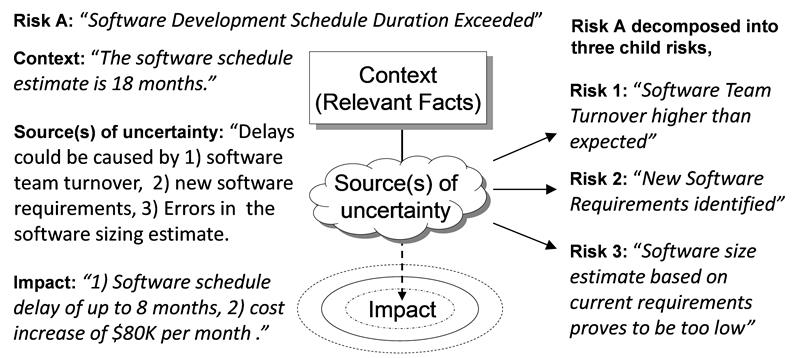A brief guide
Practical Project Risk Management
SERIES ARTICLE
By Martin Hopkinson
United Kingdom
Purposes
- Decompose risks over successive iterations of a top-down multicycle process, or
- Identify risk relationships for assessment, modelling or management purposes, or
- Rationalize the number of risks to improve process deliverability, clarity or coherence
Approach
It is important that risks are understood clearly. The most common approach to this issue is to develop risk descriptions (see Risk Descriptions guidance sheet). A sound risk descriptions approach should enable the identification of source-orientated parent-child risk relationships.
For illustrative purposes, the example below is a simple one typical of a detailed risk register. The same principle can be used to decompose risk from higher level composite risks. Note that risks might also be broken down into different strands of impact e.g. to structure a risk model.

Exercising Judgement
In theory one can continue to decompose almost any risk ad infinitum. Selecting the appropriate the level of risk decomposition is therefore a matter of judgement:
Reasons for decomposing
- During an iteration of a top-down multicycle process, it may become evident that one or more aspects of risk are particularly significant. It would then make sense to decompose these aspects preferentially for the purposes of further analysis and action during the next iteration of the process.
- Decomposing risks may achieve an improved understanding of related sources of uncertainty and hence lead to the identification of more effective risk responses.
- Decomposed child risks might be easier to allocate to appropriate risk owners.
More…
To read entire article, click here
Editor’s note: This series of articles is by Martin Hopkinson, author of the books “The Project Risk Maturity Model” and “Net Present Value and Risk Modelling for Projects” and contributing author for Association for Project Management (APM) guides such as Directing Change and Sponsoring Change. These articles are based on a set of short risk management guides previously available on his company website, now retired. For an Introduction and context for this series, click here. Learn more about Martin Hopkinson in his author profile below.
How to cite this paper: Hopkinson, M. (2022). Source-orientated Parent-Child Risk Breakdown: A brief guide, Practical Project Risk Management series, PM World Journal, Vol. XI, Issue VII, July. Available online at https://pmworldlibrary.net/wp-content/uploads/2022/07/pmwj119-Jul2022-Hopkinson-parent-child-risks-practical-risk-management-article.pdf
About the Author

Martin Hopkinson
United Kingdom
![]()
Martin Hopkinson, recently retired as the Director of Risk Management Capability Limited in the UK, and has 30 years’ experience as a project manager and project risk management consultant. His experience has been gained across a wide variety of industries and engineering disciplines and includes multibillion-pound projects and programmes. He was the lead author on Tools and Techniques for the Association for Project Management’s (APM) guide to risk management (The PRAM Guide) and led the group that produced the APM guide Prioritising Project Risks.
Martin’s first book, The Project Risk Maturity Model, concerns the risk management process. His contributions to Association for Project Management (APM) guides such as Directing Change and Sponsoring Change reflect his belief in the importance of project governance and business case development.
In his second book Net Present Value and Risk Modelling for Projects he brought these subjects together by showing how NPV and risk modelling techniques can be used to optimise projects and support project approval decisions. To learn more about the book, click here.
To view other works by Martin Hopkinson, visit his author showcase in the PM World Library at https://pmworldlibrary.net/authors/martin-hopkinson/









